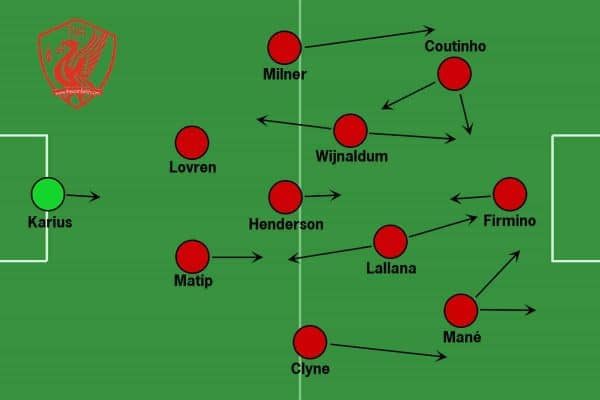
Okay, here’s an extensive article (approximately 1200 words) in English about football transfer release clauses, focusing on the facts, nuances, and strategic implications.
The Unseen Hand: Unpacking the Facts and Fiction of Football Transfer Release Clauses
In the high-stakes theatre of professional football, where billions of dollars change hands and the destinies of clubs and careers are shaped in mere weeks, few elements are as potent and often misunderstood as the "release clause." More than just a contractual figure, it’s a legal minefield, a strategic tool, and frequently, the catalyst for some of the sport’s most dramatic transfers. While often presented as a simple buyout price, the reality of release clauses is far more complex, intertwined with legal frameworks, economic pressures, and the ever-shifting balance of power between clubs and players.
What Exactly is a Release Clause? The Legal Foundation
At its core, a release clause, often termed a "buyout clause" or "termination clause," is a contractual provision that specifies a fixed fee for which a player can unilaterally terminate their contract. Upon payment of this sum, the club is legally obligated to release the player, irrespective of their desire to keep him. This mechanism bypasses the traditional negotiation process between two clubs, transforming a transfer from a bilateral agreement into a unilateral action by the player (albeit usually with the financial backing of a new club).
The prevalence and legal standing of release clauses vary significantly across different footballing nations. The most prominent example, and indeed the birthplace of their mandatory nature, is Spain. Under Royal Decree 1006/1985, a Spanish law designed to protect workers’ rights, every professional footballer’s contract must include a release clause. This legislation was enacted to prevent clubs from effectively "enslaving" players by perpetually holding onto their contracts, giving players a legal avenue to unilaterally break free. Consequently, every player in La Liga, from the biggest superstar to the youth academy hopeful, has a publicly known or internally understood release clause embedded in their contract.
Portugal also widely employs release clauses, albeit not always under the same mandatory legal framework as Spain. In other major European leagues – such as the Premier League, Bundesliga, Serie A, and Ligue 1 – release clauses are optional. While clubs and players can agree to include them, they are far less common and are often strategically deployed rather than being a standard contractual fixture. When they do appear, they are often heavily negotiated and carefully worded to protect the club’s interests.
The Dual Purpose: Club Protection vs. Player Liberty
The existence of release clauses serves a dual, often conflicting, purpose for clubs and players:
For Clubs:
- Valuation and Deterrence: For selling clubs, a high release clause acts as a powerful deterrent against unwanted bids. It sets a minimum acceptable valuation for their prized asset, preventing rival clubs from "tapping up" players with low-ball offers. In Spain, especially, clubs use these clauses to safeguard their investments, particularly after acquiring players for substantial fees.
- Financial Planning: Knowing a player’s release clause can help a club with long-term financial planning, as it represents a potential future income stream, albeit one that is out of their direct control.
- Negotiating Leverage (Indirect): While the clause bypasses direct negotiation, its existence can sometimes be used by the selling club to demand a price close to the clause value for players without one, setting a market benchmark.
For Players (and their Agents):
- Exit Strategy: For players, a release clause is the ultimate escape route. It provides a clear, predefined path to move to another club, even if their current club is unwilling to negotiate a transfer. This is particularly valuable for ambitious players seeking to join bigger clubs, play in more prestigious competitions (like the Champions League), or secure higher wages.
- Increased Leverage: The presence of a release clause, especially a reasonable one, gives players significant leverage during contract negotiations. If a club is unwilling to meet their wage demands or offer the career progression they desire, the player can point to the clause as a viable alternative for their departure.
- Career Control: In an industry where players’ careers are relatively short, having a release clause provides a degree of control over their destiny, ensuring they are not indefinitely tied to a club that may no longer align with their ambitions.
The Mechanics of Activation: A Legal Loophole
The process of activating a release clause is peculiar and often misunderstood. Legally, the player is the one who "buys out" their own contract. The new club does not directly pay the release clause to the selling club. Instead, the new club provides the player with the funds, which the player then deposits with La Liga (or the relevant footballing authority) as a payment to terminate their contract. La Liga then transfers these funds to the selling club. This legal nuance is crucial because it frames the transaction as a player’s right to terminate their employment, rather than a transfer fee paid directly by one club to another.
This mechanism ensures the player’s right to freedom of work is upheld, as enshrined in Spanish law. Once the clause is paid, the player is technically a free agent, immediately available to sign for the new club. The selling club has no legal recourse to block the move, only to receive the specified funds.
Noteworthy Examples and Their Impact
The history of football is dotted with high-profile transfers triggered by release clauses, each leaving a significant mark on the market:
- Neymar Jr. to Paris Saint-Germain (2017): This was the seismic event that redefined the transfer market. PSG activated Neymar’s €222 million release clause at Barcelona, shattering the world transfer record. This single transaction immediately inflated player valuations globally and demonstrated the immense financial power of state-backed clubs. It also highlighted the vulnerability of even the biggest clubs to a well-funded rival if a star player has an attainable release clause.
- Antoine Griezmann to Barcelona (2019): Griezmann’s move from Atlético Madrid to Barcelona was fraught with controversy. His release clause dropped from €200 million to €120 million on July 1, 2019. Barcelona waited for this date, but Atlético accused them of "tapping up" the player and negotiating with him before the clause dropped, demanding the higher fee. The case highlighted the ethical grey areas surrounding release clauses and the potential for disputes.
- João Félix to Atlético Madrid (2019): After losing Griezmann, Atlético Madrid immediately reinvested by activating the €126 million release clause of then-teenager João Félix from Benfica. This demonstrated the ripple effect of large release clause payments, with clubs often forced to pay equally exorbitant fees to replace outgoing stars.
- Erling Haaland to Manchester City (2022): While not a Spanish release clause, Haaland’s move from Borussia Dortmund to Manchester City for a reported €60 million (significantly below his market value) was triggered by a pre-agreed "gentleman’s agreement" or a specific clause that activated only after a certain period at Dortmund. This showed how clubs outside Spain can use similar mechanisms to secure future talent at a pre-determined, often more favourable, price.
These examples underscore how release clauses, particularly in Spain, are not just hypothetical figures but active, market-shaping realities.
Strategic Nuances and Variations
Beyond the standard fixed fee, release clauses can come with various strategic nuances:
- Escalating Clauses: Some clauses are designed to increase over time or based on performance metrics (e.g., if a player wins a major award or plays a certain number of games). This protects the selling club’s investment as the player’s value potentially grows.
- Decreasing Clauses: Less common, but sometimes clauses decrease under specific conditions, such as relegation, or after a certain number of years into a long contract, providing an exit route for the player if the club’s fortunes decline.
- Conditional Clauses: These can be highly specific, such as a clause that is only valid if a team qualifies for the Champions League, or one that prevents a player from joining a direct rival. While the latter might be legally challenged under competition laws, they are sometimes attempted.
- Buy-Back Clauses: Often inserted when selling young players, particularly in Spain. These clauses allow the selling club to re-acquire the player for a pre-determined fee, usually higher than the original sale price, if they develop into a star elsewhere. Real Madrid and Barcelona famously use these for their academy graduates.
- Anti-Rival Clauses: A specific type of conditional clause, often with an inflated value, designed to make it prohibitively expensive for a player to join a direct competitor. For example, a player might have a €100m clause for foreign clubs but a €200m clause for a domestic rival.
Economic and Tactical Implications
The prevalence of release clauses has profound economic and tactical implications for football:
- Market Inflation: High release clauses, especially when activated, contribute to the overall inflation of player values. Clubs become accustomed to paying astronomical sums, which in turn drives up transfer fees for players without clauses.
- Risk for Selling Clubs: A club that signs a player for a low fee and then inserts a relatively modest release clause risks losing a valuable asset prematurely if the player’s performance explodes. Conversely, setting an impossibly high clause might deter potential suitors and leave the player feeling trapped, potentially leading to dissatisfaction.
- Opportunity for Buying Clubs: For well-funded clubs, a release clause represents a clear, fixed price for a player, removing the uncertainties and prolonged negotiations of traditional transfers. It allows for swift, decisive action.
- Agent Influence: Player agents often push for release clauses, or for clauses that decrease over time, to maintain leverage and facilitate future moves, which can also generate new commission fees for them.
- FFP Considerations: Activating a massive release clause can have significant implications for a club’s Financial Fair Play (FFP) standing, as it represents a huge, immediate cash outflow that must be balanced by revenues or player sales.
Controversies and Ethical Debates
Despite their legal grounding, release clauses frequently spark controversy:
- "Tapping Up": The mechanism of a player buying out their contract often leads to accusations of "tapping up," where the buying club (or its agents) are alleged to have directly negotiated with the player before formally approaching the selling club. While illegal under FIFA rules, proving it is notoriously difficult, especially when a release clause exists.
- Fairness to Selling Clubs: Many argue that release clauses undermine the spirit of transfer negotiations, forcing clubs to sell players against their will, often at a price that, while high, may still be below the player’s true market value in a competitive bidding scenario.
- Player Power vs. Club Investment: The debate often boils down to balancing a player’s right to freedom of movement against a club’s significant investment in their development, wages, and contract.
The Future of Release Clauses
As football continues to evolve, so too will the role of release clauses. We can expect:
- Continued Inflation: As club revenues grow and the demand for elite talent intensifies, release clauses, especially for top-tier players in Spain, will likely continue their upward trajectory.
- Strategic Deployment: In leagues where they are optional, clubs will likely continue to use them selectively – either to secure a prized asset with an enticing, but high, figure, or as a tactical tool to manage player expectations and potential departures.
- Legal Challenges and Refinements: The legal frameworks surrounding release clauses may face future challenges or refinements, particularly concerning their interaction with FFP regulations and broader competition laws.
- Player Power: As player power continues to grow, agents will undoubtedly push for more favourable release clause conditions, making them a central point of contention in contract negotiations.
Conclusion
Release clauses are a fascinating and complex facet of modern football. Far from being a simple price tag, they are deeply rooted in legal history, serve as powerful strategic instruments for both clubs and players, and have irrevocably shaped the economic landscape of the transfer market. While they offer players a crucial avenue for career progression and autonomy, they simultaneously expose clubs to the risk of losing their prized assets against their will. As the game continues its relentless march towards greater commercialisation and global reach, the "unseen hand" of the release clause will undoubtedly continue to play a pivotal role in scripting the dramatic sagas of football transfers.



